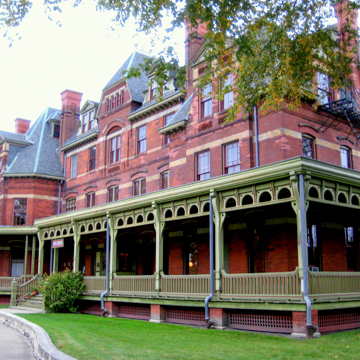Hotel Florence was built in 1881 to accommodate the railroad business executives traveling to the Town of Pullman. Located south of the Administration Building on the northeast corner of a large, formally landscaped square, the four-story, red brick building features a steeply pitched slate roof with dormer windows and an intricate, cut wood porch that wraps around much of the structure. The Hotel contained 50 guest rooms, a dining room, men’s and women’s parlors, a billiard room, and a bar. Although Pullman outlawed the sale of alcohol in his company town, he made an exception for guests of the hotel.
The Hotel is named after George Pullman’s eldest daughter, and the Pullman family had a suite permanently reserved for their personal use. The building’s richly appointed interior featured cherry woodwork in the first floor and the Pullman Suite on the second floor. Guest rooms, outfitted with Eastlake furniture, were located on the second through fourth floors, with the more elegant rooms located on the second floor closer to the lobby. The Hotel featured gas lighting and steam radiator heat, generated by the Corliss steam engine in the factory adjacent to the Administration Building across the street. In 1914, Hotel Florence was expanded with the addition of an annex on the northeast side of the building, where the service wing is located.
The hotel was not spared when the decline of the railroad industry in the middle of the twentieth century shuttered the Pullman factory. It simply could not survive without guests who had business at the factory. In 1975 the Historic Pullman Foundation purchased the hotel building to save it from demolition, but it remained empty until 1991, when the Illinois Historic Preservation Agency purchased it as part of the Pullman State Historic Site. It is now open for tours and special events and has undergone $3.5 million of capital improvements. The Hotel Florence is now part of the Pullman National Monument.
References
Crawford, Margaret. Building the Workingman’s Paradise: the Design of American Company Towns. London: Verso, 1995.
Dinus, Oliver J., and Angela Vergara. Company Towns in the Americas. Athens: University of Georgia Press, 2011.
Jackson, Donald, and Carol Poh Miller, “Pullman Industrial Complex,” Cook County, Illinois. Historic American Engineering Record, 1976. National Park Service, U.S. Department of the Interior, Washington, D.C.
Lillibridge, Robert M., “Pullman: Town Development in the Era of Eclecticism,” Journal of the Society of Architectural Historians12, no. 3 (October 1953): 17-22.
Lindsey, Almont. The Pullman Strike: The Story of a Unique Experiment and of a Great Labor Upheaval. Chicago: University of Chicago Press, 1942.
Snell, Charles, “Pullman Historic District,” Cook County, Illinois. National Register of Historic Places Nomination Form, 1970. National Park Service, U.S. Department of the Interior, Washington, D.C.








